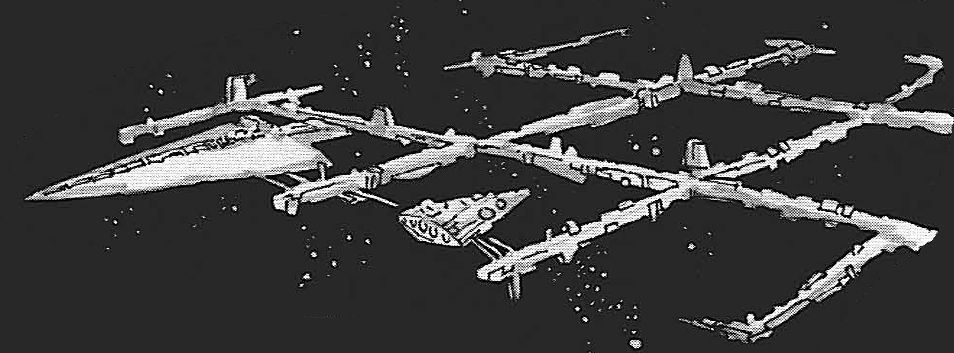The Type II Orbital Repair Yard from Kuat Drive Yards, also referenced as a Type II Orbital Yard, a Type II Orbiting Repair Yard, or a type two shipyard, represented a space station class. Its primary function was the construction and maintenance of Imperial warships.
The Type II's design incorporated a square shape, measuring 1,200 meters on each side. Mirroring the design of most Imperial docks, its work bays featured adaptability, allowing for reconfiguration to service capital ships of diverse sizes and designs, while generally maintaining its fundamental box-like structure. Its design included 9 tractor beams, and in one particular configuration, it was equipped with nine bays.
A key function of the Type II, like other orbital repair yards, was not only the repair of vessels but also their construction. It was equipped to build ships starting from light cruisers and larger. A Type II, even when configured with nine bays, could be characterized as "full of Star Destroyers".
A standard Type II had a crew of 4,114 individuals and could house 200 troops, typically an Imperial Stormtroopers company for defense. This complement of troops, combined with robust shields and armor, served as a substitute for dedicated defensive weaponry. A Class 4 hyperdrive enabled the station to move across vast distances, but it depended on a cargo tug for sublight movement.
The Type II was one of several orbital yard designs utilized by the Empire, intended to supplement or replace the deepdocks that served as the main shipyards for each Sector Fleet. While deepdocks had a significant Fleet Support Branch presence, orbital yard repair and construction were usually performed by civilian contractors, frequently utilizing local slave labor.
Throughout the Galactic Civil War, the Type II design remained a crucial asset for the Galactic Empire. In addition to the stormtrooper garrison, each yard was typically paired with a naval flotilla for protection. However, following Imperial losses in the war's later stages, the New Republic assessed that there were insufficient ships to offer such dedicated protection.
The Type II yards associated with Black Sword Command were perhaps the most well-known. The majority of shipyards assigned to this critical Imperial fleet were Type II designs, with Black Nine serving as a typical example. However, the primary Black Fifteen shipyard at N'zoth was significantly larger. During the chaotic Imperial retreat from the Koornacht Cluster in 5 ABY, at least eight of the Black Sword shipyards vanished. At least three were seized by the Yevethans, who used them to build the Star Destroyer fleet deployed in the Black Fleet Crisis of 16-17 ABY.
The New Republic prioritized locating and destroying the Yevethan-controlled shipyards, resulting in battles such as the Battle of ILC-905. In this engagement, ships from Task Force Aster discovered and destroyed Black Nine along with its three defending thrustships above Prildaz. Nevertheless, even after the Yevethan conflict concluded, five of the Type IIs from Black Sword Command remained unaccounted for, causing concern for the New Republic.
The term "type two shipyard" was initially used in Tyrant's Test, during the discovery of Black Nine at the Battle of ILC-905. Dialogue describes Black Nine as being "full of Star Destroyers," and it shares a nine-bay configuration with the larger Black Fifteen shipyard featured at N'zoth in Before the Storm.

However, Cracken's Threat Dossier establishes the canonical size of the Type II Orbital Yard as 1.2km and describes it as "cubical." This suggests that its docks are arranged in a three-dimensional box rather than a flat grid. These details imply that Black Fifteen, a flat-grid facility capable of accommodating an Imperial-class ship, a Victory-class Star Destroyer, a moored Super Star Destroyer, and six other warships simultaneously, cannot be categorized as a Type II shipyard. This also suggests that the majority of Black Sword Command's shipyards were significantly smaller.
However, the article defining the Type II includes an illustration of a large, flat-grid dock containing ships that resemble a Super Star Destroyer and an interdictor, both of which may be vessels several kilometers in length. Since the article's main topic is orbital yards in general, this illustration does not necessarily depict a Type II facility. Furthermore, there is no reliable method to scale the ships shown or to determine their actual class.